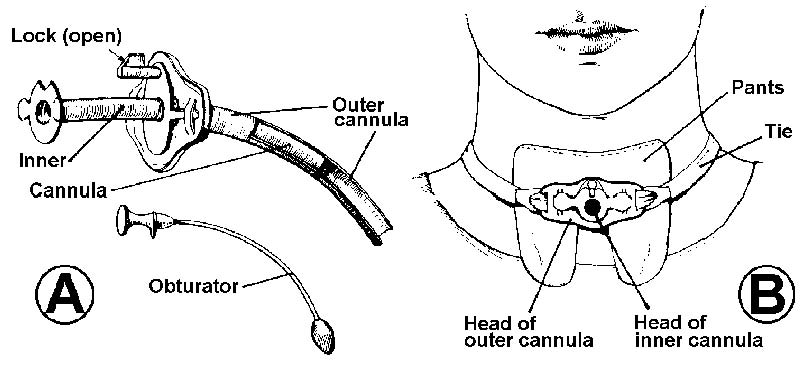Special Surgical Procedures II
LESSON 1: Eye, Ear, Nose, and Throat (EENT) Surgery
Section IV: THROAT, TONGUE, AND NECK SURGERY
1-38
1-38. ELECTIVE TRACHEOSTOMY
a. General. This procedure involves opening the trachea and inserting a cannula through a midline incision in the neck, below the cricoid cartilage. It is used as an emergency procedure to treat upper respiratory tract obstruction and as a prophylactic measure in the presence of chronic lung disease in which an obstruction could occur. A prophylactic tracheostomy is performed at the time of surgery, thus providing for easy and frequent aspiration of the tracheobronchial tree and diminishing the dead space that exists from the opening of the mouth down to the supraclavicular region. The creation of a new clearance (tracheostomy) nearer to the functional areas in the lung provides for greater volume of air for the patient with a partly destroyed lung. Anesthesia may be maintained via a prophylactic tracheostomy.
b. Preparation of the Operating Room. The standard instruments and other items needed are kept sterile in a pack, ready for immediate use. In addition, the circulator is to have a cardiac arrest tray immediately available.
c. Preparation of the Patient. The patient is placed in a dorsal recumbent position, with the shoulders raised by a folded sheet to hyperextend the neck and head. The neck is cleansed and sterile drapes applied as for operations of the thyroid.
d. Operative Procedure.
(1) A vertical or transverse incision may be used. A vertical incision is made in the midline from approximately the cricoid cartilage to the suprasternal notch. When a transverse incision is made, it extends approximately one fingerbreadth above the suprasternal notch parallel to it and from the anterior border of one sternocleidomastoid muscle to the opposite side. Soft tissues and muscle are divided, and the isthmus of the thyroid gland that joins both lobes of the gland in the midline over the trachea is retracted in an upward direction with Cushing retractors, thus resulting in exposure of the underlying tracheal rings, usually the third and fourth. In some cases, two curved clamps may be inserted through this incision across the isthmus and the isthmus transected. The transected ends of the isthmus are secured with chromic gut sutures.
(2) With a knife and #15 blade, a vertical incision is made in the trachea directly across the two tracheal rings. The cut ends of the cricoid cartilage are retracted with a hook.
(3) The previously prepared tracheostomy tube (see figure 1-12) is inserted into the trachea, the obturator is quickly removed, and the trachea is suctioned with a catheter.
(4) The wound edges are lightly approximated with silk sutures or the wound edges are allowed to fall together around the tube. One or two skin sutures are inserted above the tube. The lower angle of the wound may be left open for drainage.
Figure 1-12. Metal tracheostomy tube. A-Parts of a metaltracheostomy tube.
B-Tracheostomy ties and gauze pants in place.
(5) The tracheostomy tube is held in place with tapes tied with a square knot behind the neck. The inner tube is then inserted. A gauze dressing split around the tube is applied to the wound. Assembler


